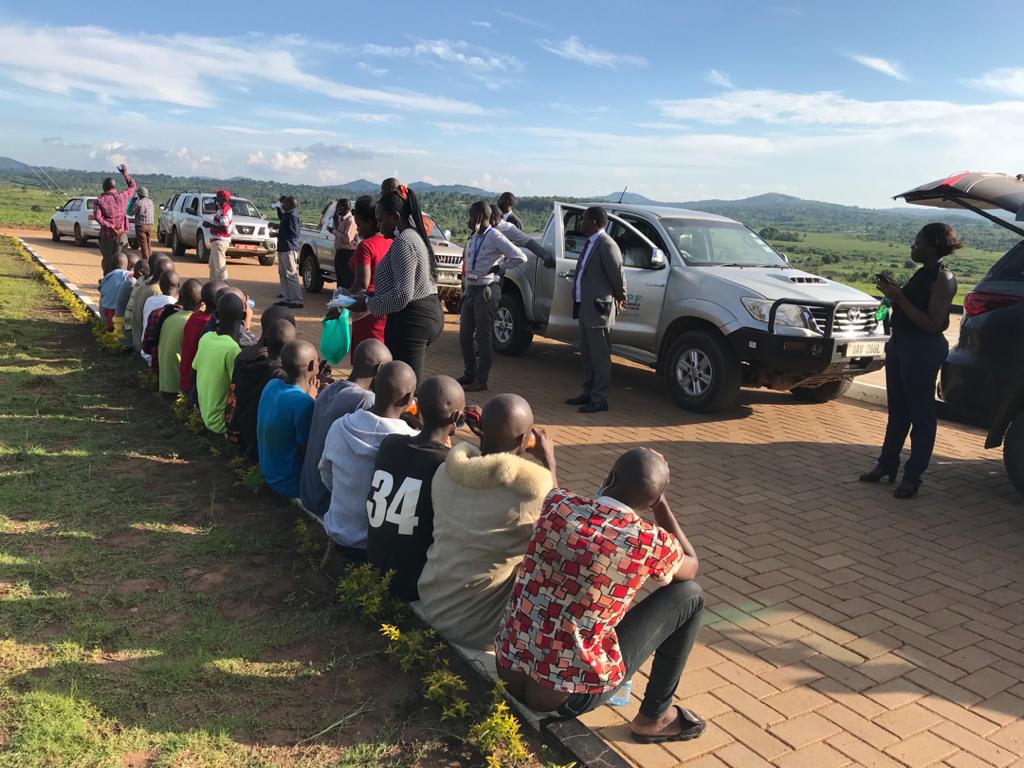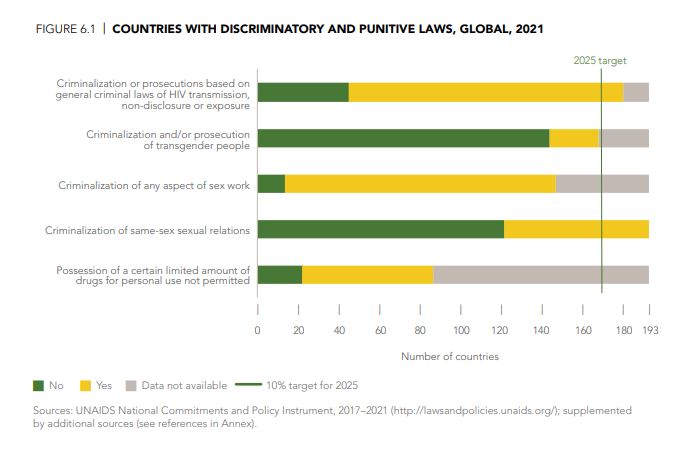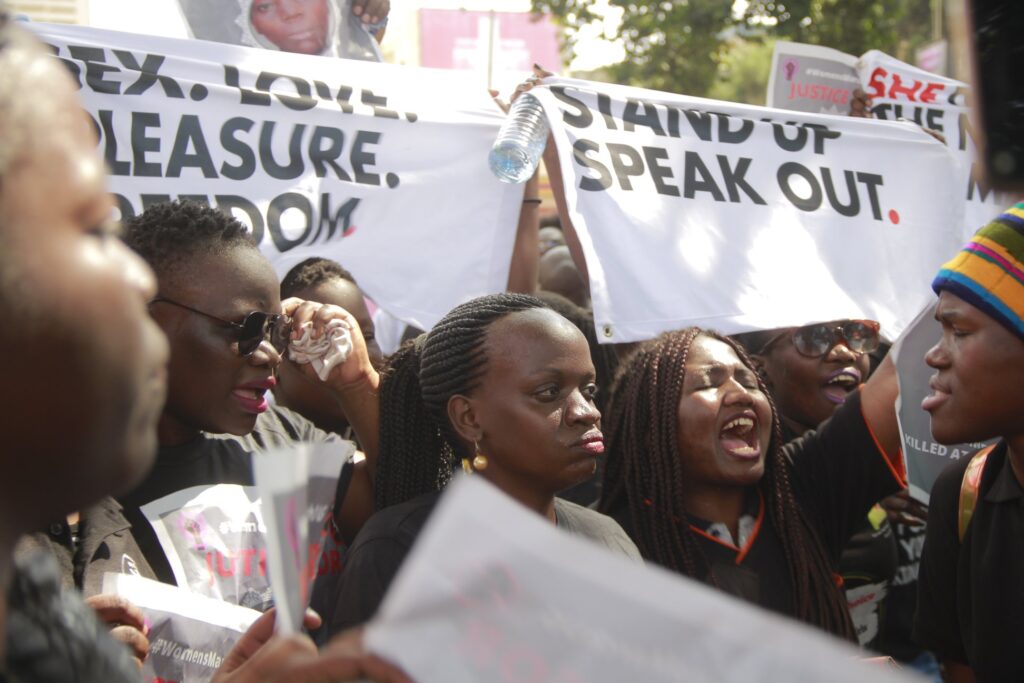UN agency: Gay and trans criminalization fuels HIV / AIDS
Kikonyogo Kivumbi is the executive director of the Uganda Health…
Criminalization of transgender people, homosexuality, and sex work holds back global advances in the fight against HIV/AIDS, according to a new report by UNAIDS.

The 2021 UNAIDS Global Update, titled Confronting Inequalities: Lessons for pandemic responses from 40 years of AIDS, shows a positive correlation between better HIV outcomes and the adoption of laws that advance non-discrimination. It cites a study from sub-Saharan Africa which found that HIV prevalence among sex workers was 39% in countries that criminalized sex work, compared to 12% in countries where sex work was partially legalized.
The Global AIDS Strategy 2021-2016 elaborates on the 2021 UN Political Declaration on AIDS, which called on countries to eliminate legal and policy obstacles to accessing HIV services, with specific targets (90-90-90 targets) to be reached by 2025:
- Less than 10% of countries criminalize sex work, possession of small amounts of drugs, same-sex sexual behaviour, and HIV transmission, exposure or non-disclosure.
- Less than 10% of countries lack mechanisms for people living with HIV and key populations to report abuse and discrimination and seek redress.
- Less than 10% of people living with HIV and key populations lack access to legal services.
Although several countries have decriminalized same-sex sexual relations in recent years, at least 69 UN member states maintain laws that criminalize homosexuality. The report also notes that every country that reported to UNAIDS criminalizes at least one of the behaviours that it is calling to decriminalize.

The report also points to what countries that have not achieved the 90-90-90 targets can do. It specifically recommends that many of the 19 countries that achieved the 90-90-90 targets by 2020 had been leaders in differentiated service delivery, where facility-based services are complimented by community-led services. Most have also included key populations as central to their response.
A full press release by UNAIDS to coincide with the report release is reproduced verbatim below:
PRESS RELEASE
UNAIDS report shows that people living with HIV face a double jeopardy, HIV and COVID-19, while key populations and children continue to be left behind in access to HIV services

People living with HIV are at a higher risk of severe COVID-19 illness and death, yet the vast majority are denied access to COVID-19 vaccines. Key populations and their sexual partners account for 65% of new HIV infections but are largely left out of both HIV and COVID-19 responses—800,000 children living with HIV are not on the treatment they need to keep them alive
GENEVA, 14 July 2021—The UNAIDS Global AIDS Update 2021, launched today, highlights evidence that people living with HIV are more vulnerable to COVID-19, but that widening inequalities are preventing them from accessing COVID-19 vaccines and HIV services.
Studies from England and South Africa have found that the risk of dying from COVID-19 among people living with HIV was double that of the general population. In sub-Saharan Africa, which is home to two thirds (67%) of people living with HIV, less than 3% had received at least one dose of a COVID-19 vaccine by July 2021. At the same time, HIV prevention and treatment services are eluding key populations, as well as children and adolescents.
COVID-19 vaccines could save millions of lives in the developing world but are being kept out of reach as rich countries and corporations hold on tightly to the monopoly of production and delivery of supplies for profit. This is having a severe impact around the world as health systems in developing countries become overwhelmed, such as in Uganda, where football stadiums are being turned into makeshift hospitals.
“Rich countries in Europe are preparing to enjoy the summer as their populations have easy access to COVID-19 vaccines, while the global South is in crisis,” said Winnie Byanyima, Executive Director of UNAIDS. “We have failed to learn the lessons of HIV, when millions were denied life-saving medicines and died because of inequalities in access. This is totally unacceptable.”
The new UNAIDS report shows how COVID-19 lockdowns and other restrictions have badly disrupted HIV testing—in many countries this has led to steep drops in HIV diagnoses, referrals to care services and HIV treatment initiations. In KwaZulu-Natal, South Africa, for example, there was a 48% drop in HIV testing after the first national lockdown was imposed in April 2020. There were also fewer new HIV diagnoses and a marked drop in treatment initiation. This occurred as 28,000 HIV community health-care workers were shifted from HIV testing to COVID-19 symptom screening.
The report, Confronting inequalities, shows that in 2020 the 1.5 million new HIV infections were predominantly among key populations and their sexual partners. People who inject drugs, transgender women, sex workers and gay men and other men who have sex with men, and the sexual partners of these key populations, accounted for 65% of HIV infections globally in 2020. Key populations accounted for 93% of new HIV infections outside of sub-Saharan Africa, and 35% within sub-Saharan Africa. However, they remain marginalized and largely out of reach of HIV services in most countries.
The report shows that many of the 19 countries that achieved the 90–90–90 targets by 2020 have been leaders in differentiated service delivery, where facility-based services are complimented by community-led services. Most have also included key populations as central to their responses. In Estonia, for example, the expansion of comprehensive harm reduction services was followed by a 61% countrywide reduction in HIV infections and a 97% reduction in new HIV infections among people who inject drugs.
HIV testing and treatment has been scaled up massively over the past 20 years. Some 27.4 million of the 37.7 million people living with HIV were on treatment in 2020. However, gaps in service provision are much larger for children than for adults. In 2020, around 800,000 children aged 0-14 years who were living with HIV were not on HIV treatment. Treatment coverage was 74% for adults but just 54% for children in 2020. Many children were not tested for HIV at birth and remain unaware of their HIV status, making finding them and bringing them into care a major challenge.

Confronting inequalities also shows that women and girls in sub-Saharan Africa continue to be at a higher risk of HIV infection, with gender inequality and gender-based violence at the centre of that risk. Gender inequalities and gender-based violence rob women and girls of their fundamental human rights, including the right to education, health and economic opportunities. This increases their risk of HIV infection and blocks access to services. In sub-Saharan Africa, adolescent girls and young women account for 25% of all new HIV infections despite representing just 10% of the population.
Poverty and lack of schooling are also formidable barriers to health and HIV services. The report shows how family planning services for women and voluntary medical male circumcision for men and boys are much less likely to be accessed by people living in poverty. In 2020, the number of voluntary medical male circumcisions dropped by more than 30% in 15 priority countries in eastern and southern Africa.
Poverty is also a driver of migration, which has been shown to severely impact access to HIV services and puts lives in danger as migrants flee conflict and poverty in the hope of safety and economic security.
“Billionaires are sailing their yachts in the same Mediterranean waters that migrants are drowning in,” said Winnie Byanyima. “How can we stand by and let this be the ‘new normal’? We must confront these horrific inequalities and put the emphasis back on respect for basic, fundamental human rights.”
Inequalities are not naturally occurring. They are the result of policy and programmatic actions that divide rather than include. For example, key populations are marginalized and criminalized for their gender identities and expression, sexual orientation and livelihoods. New analysis included in the report shows a positive correlation between better HIV outcomes and the adoption of laws that advance non-discrimination. A study from sub-Saharan Africa found that HIV prevalence among sex workers was 39% in countries that criminalized sex work, compared to 12% in countries where sex work was partially legalized.
“We are 40 years into the fight against HIV. Both the successes and the failures have taught us that we cannot prepare for or defeat a pandemic unless we tear down inequalities, promote people-centred, rights-based approaches and work together with communities to reach everyone in need,” said Ms Byanyima.

Kikonyogo Kivumbi, the author of this article, is the executive director of the Uganda Health and Science Press Association. Contact him at uhspauganda@gmail.com.




Bisexual man asks Qtalk: How should I tell my family?